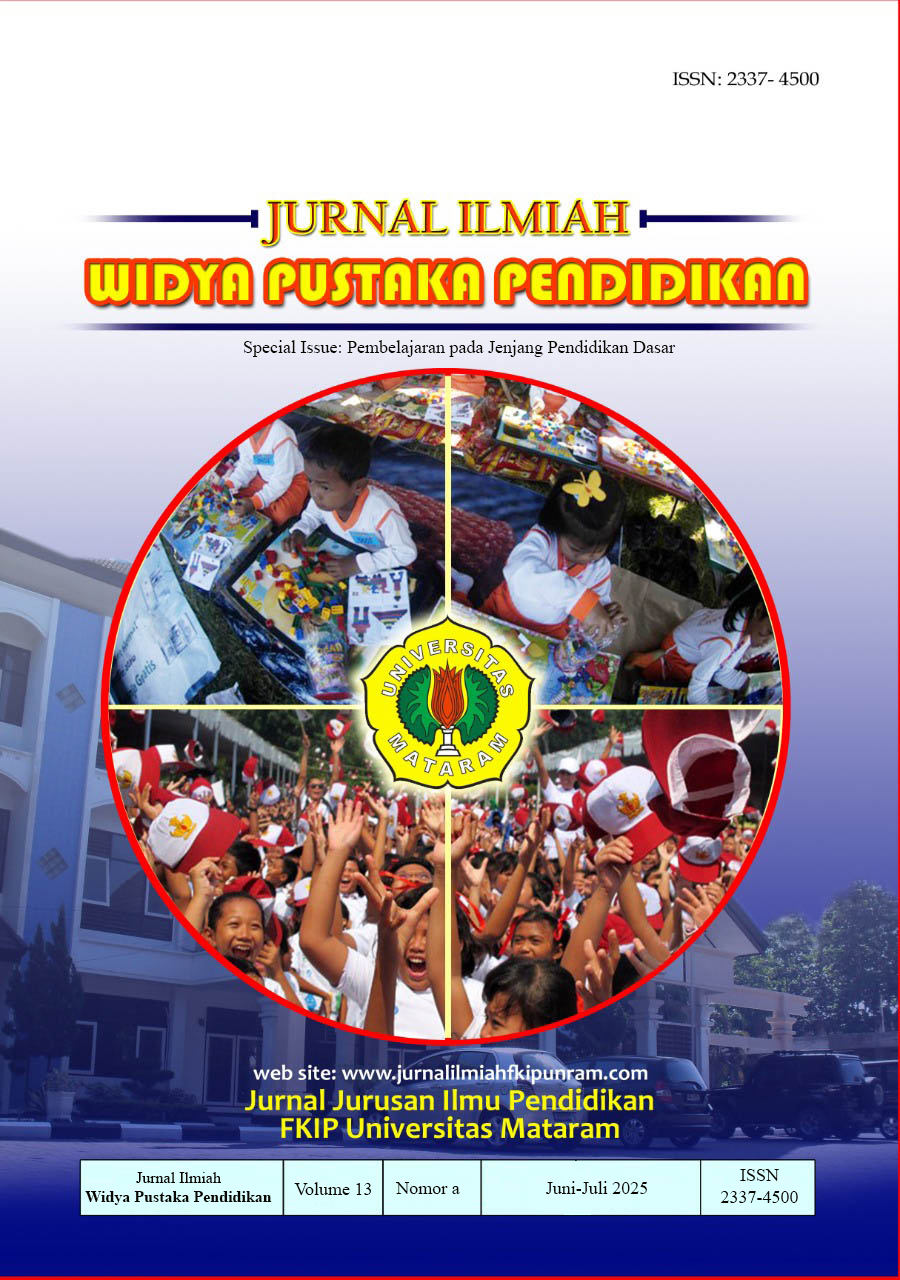ANALISIS KESULITAN MEMBACA SISWA DENGAN MODEL TEMATIK FRAGMENTED PADA PEMBELAJARAN BAHASA INDONESIA DI SDN 32 CAKRANEGARA
Abstract
This study aims to describe the factors causing reading difficulties among fourth-grade students at SDN 32 Cakranegara and identify effective intervention strategies to address them. A descriptive qualitative approach was employed, with data collected through participatory observation, in-depth interviews, reading tests, and documentation. The findings revealed that reading difficulties were influenced by a lack of phonological awareness, limited family support, and suboptimal teaching methods. To overcome these challenges, interventions such as the phonics method, multisensory learning, educational technology, and active involvement of teachers and parents were implemented. These strategies were applied within the fragmented thematic learning model, which allows a focused approach to reading skills within the Indonesian language subject. The results highlight the importance of an integrated and collaborative approach in improving reading abilities among elementary students with literacy difficulties. This research is expected to serve as a reference for planning instruction and early intervention in creating an inclusive literacy environment.
References
Anderson, R. C., Hiebert, E. H., Scott, J. A., & Wilkinson, I. A. G. (1985). Becoming a nation of readers: The report of the Commission on Reading. Washington, DC: National Institute of Education.
Chapman, J. W., & Tunmer, W. E. (2003). A longitudinal study of beginning reading achievement and reading self‐concept. British Journal of Educational Psychology, 73(4), 505–521. https://doi.org/10.1348/000709903322591235
Creswell, J. W. (2014). Research Design: Qualitative, Quantitative, and Mixed Methods Approaches (4th ed.). Thousand Oaks, CA: SAGE Publications.
Dhieni, N. (2011). Metode Pengembangan Bahasa. Jakarta: Universitas Terbuka.
Ehri, L. C. (2005). Learning to read words: Theory, findings, and issues. Scientific Studies of Reading, 9(2), 167–188.
Epstein, J. L. (2001). School, Family, and Community Partnerships: Preparing Educators and Improving Schools. Westview Press.
Fitriani, S., & Widodo, H. (2020). Peran guru dalam meningkatkan literasi membaca siswa sekolah dasar. Jurnal Pendidikan Dasar Nusantara, 5(1), 45–53.
Gough, P. B., & Tunmer, W. E. (1986). Decoding, reading, and reading disability. Remedial and Special Education, 7(1), 6–10.
Harisah, R. (2019). Kesulitan membaca pada siswa sekolah dasar dan dampaknya terhadap prestasi belajar. Jurnal Pendidikan Dasar, 10(2), 123-130.
Isma, C. N. (2022). Program remedial membaca dalam meningkatkan literasi siswa sekolah dasar. Jurnal Literasi Sekolah Dasar, 4(1), 89–97.
Kurniawan, D., Hasanah, R., & Sulistyaningsih, E. (2021). Efektivitas metode fonik dalam pembelajaran membaca. Jurnal Inovasi Pendidikan Dasar, 6(2), 112–120.
Lyon, G. R., Shaywitz, S. E., & Shaywitz, B. A. (2003). A definition of dyslexia. Annals of Dyslexia, 53(1), 1–14.
Lonigan, C. J., Burgess, S. R., & Anthony, J. L. (2000). Development of emergent literacy and early reading skills in preschool children: Evidence from a latent-variable longitudinal study. Developmental Psychology, 36(5), 596.
Moleong, L. J. (2017). Metodologi Penelitian Kualitatif (Edisi Revisi). Bandung: Remaja Rosdakarya.
Musthafa, B. (2016). Pengembangan keterampilan membaca di sekolah dasar. Yogyakarta: Pustaka Pelajar.
National Reading Panel. (2000). Teaching children to read: An evidence-based assessment of the scientific research literature on reading and its implications for reading instruction. Washington, DC: National Institute of Child Health and Human Development.
Nurhadi. (2005). Peningkatan Kemampuan Membaca Siswa SD. Jakarta: Depdiknas.
Nurhayati, L., Handayani, D., & Subekti, M. (2023). Kolaborasi orang tua dan guru dalam meningkatkan literasi anak usia sekolah dasar. Jurnal Pendidikan Anak, 9(1), 22–29.
Piaget, J. (1970). Science of education and the psychology of the child. New York: Viking Press.
Pratiwi, S., & Ariawan, H. (2017). Pengaruh kemampuan membaca terhadap prestasi belajar siswa. Jurnal Pendidikan Bahasa Indonesia, 5(1), 45-53.
Rahman, A., & Susanto, H. (2022). Strategi remedial reading untuk anak dengan hambatan literasi dasar. Jurnal Evaluasi Pendidikan, 8(3), 143–150.
Safitri, N., & Harjono, A. (2022). Pembelajaran multisensori untuk meningkatkan kemampuan membaca anak. Jurnal Psikologi dan Pendidikan, 11(1), 67–74.
Sari, N. M. (2018). Minat baca anak usia sekolah dasar dan pengaruhnya terhadap kemampuan membaca. Jurnal Ilmiah Pendidikan Anak, 3(1), 33-40.
Snow, C. E., Burns, M. S., & Griffin, P. (1998). Preventing Reading Difficulties in Young Children. National Academy Press.
Spradley, J. P. (1980). Participant Observation. New York: Holt, Rinehart and Winston.
Sugiyono. (2019). Metode Penelitian Kualitatif, Kuantitatif, dan R&D. Bandung: Alfabeta.
Sulistiani, D., & Nugroho, A. (2020). Peran orang tua dalam meningkatkan kemampuan membaca anak usia dini. Jurnal Pendidikan Anak, 7(2), 85-92.
Sulistyo, G. H. (2011). Strategi pembelajaran membaca untuk siswa SD. Jurnal Kependidikan: Penelitian Inovasi Pembelajaran, 41(1), 72–85.
Tarigan, H. G. (2008). Membaca sebagai suatu keterampilan berbahasa. Bandung: Angkasa.
Widodo, A., & Permatasari, D. (2021). Pemanfaatan teknologi dalam meningkatkan kemampuan membaca anak usia sekolah. Jurnal Teknologi Pendidikan Dasar, 3(1), 33–41.
Yusuf, S. (2003). Psikologi Perkembangan Anak dan Remaja. Bandung: Remaja Rosdakarya.
Copyright (c) 2025 Haetul Yani, Ida Ermiana, Hilwan Jayadi, Winda Tri Rahayu

This work is licensed under a Creative Commons Attribution-NonCommercial-ShareAlike 4.0 International License.






